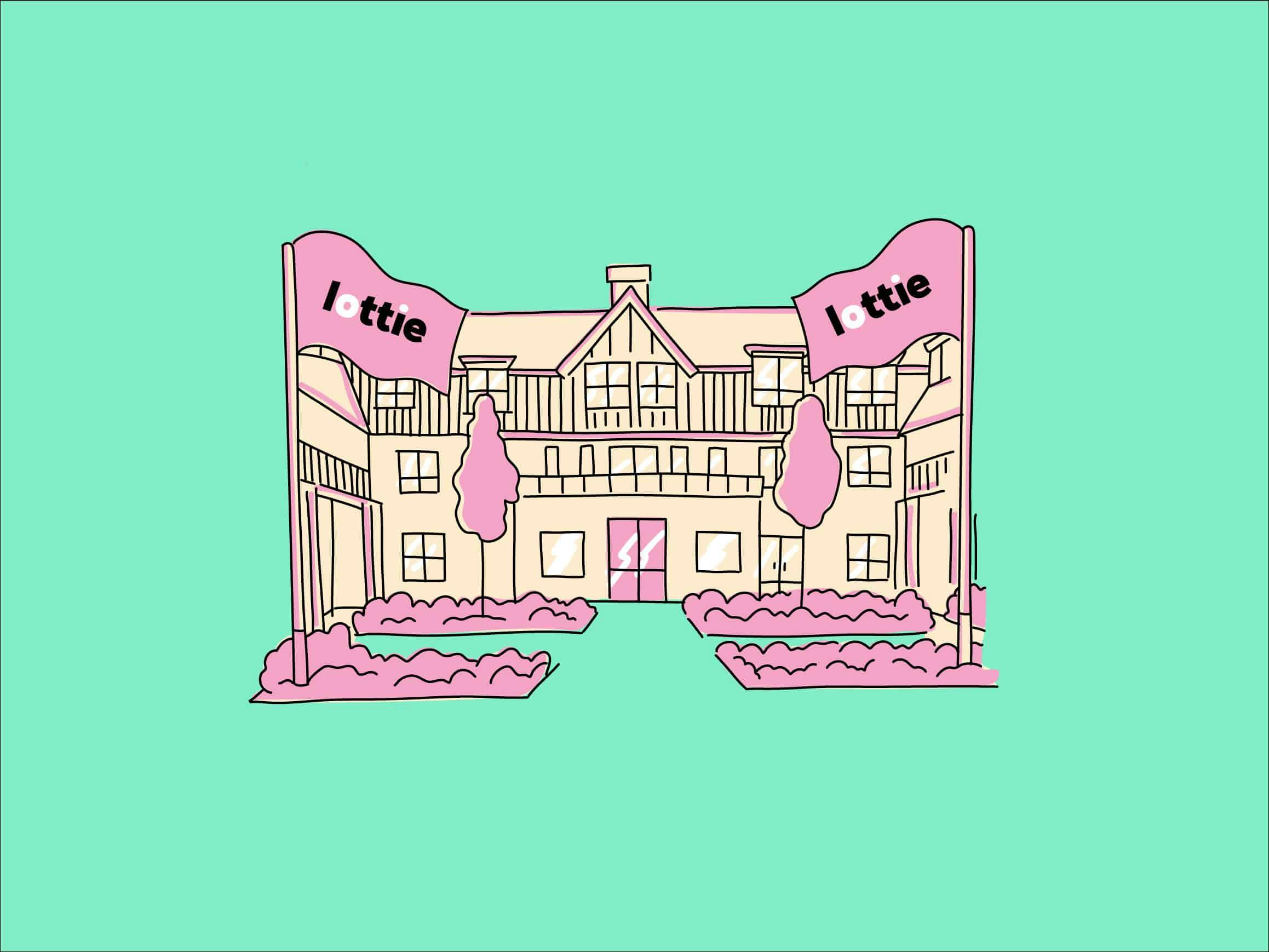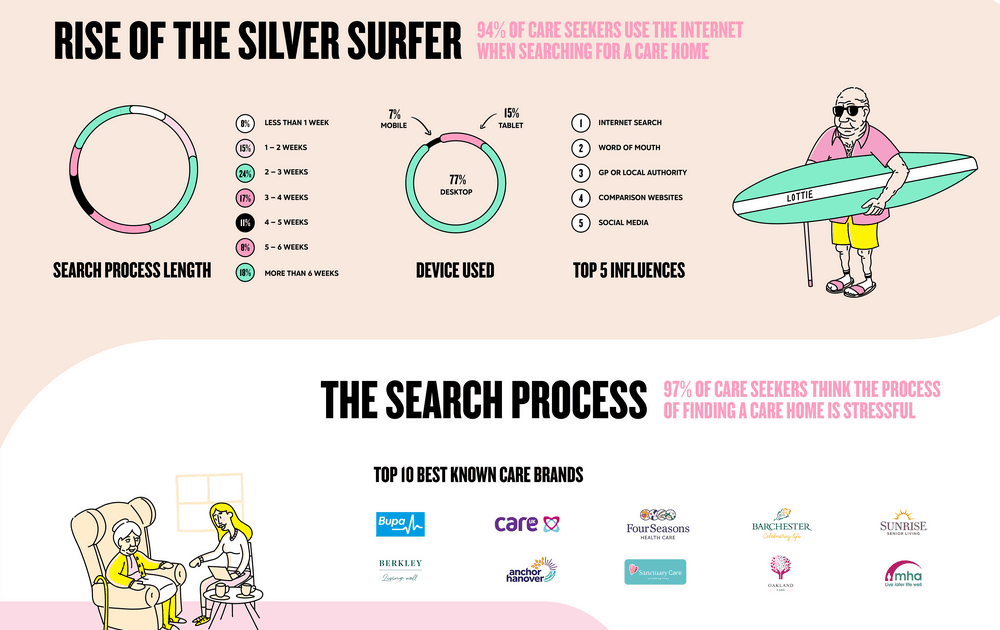What Makes a Good Care Home Experience? Our Survey Results Revealed

Estimated Reading Time: 11 minutes
There’s a lot to think about when you’re choosing a care home, but what if there was a way to know what the most in-demand care facilities are?
Luckily, now there is!
Our recent UK-wide Care Seeker Survey aimed to uncover what people really want from a care home; whether you’re searching for a home for yourself or for somebody else.
In this article, we look into the most sought-after aspects of a care home, including the culture, activities and experiences on offer. Some of the top results may surprise you.
Kickstart your care search
Discover the best care homes in your area through Lottie.
Our Care Seekers Survey Results
Our UK-wide Care Seeker Survey surveyed two different audience groups, including the Fresh group, aged 65+ and the Recontact group, aged 40-64 years old.
We asked respondents a series of questions about what they thought contributed to a good care home experience.
We've summarised the most important results in this handy infographic:

The Search Process
The first step on your care journey will be the process of actually finding a care home that you want to live in (this is where Lottie can be a big help!). Therefore the first set of questions we asked were related to this stage of the process.

The number one way that people look for a care home is via an internet search with a massive 77% making that search on a desktop computer which is contrary to most industries where searches on mobile phones make up the highest percentage now.
The decisions making process is also longer on average than others with a massive 77% of people taking longer than 2 weeks and 18% taking longer than 6 weeks to make a decision.
This isn’t surprising as it is a huge decision and should be considered carefully.
We’re here to help you find the right care home for you or your loved one. You can request a free list of care homes from our care experts, who will then share homes matching your budget, location and type of care needed. You can also search for a care home through our easy-to-use directory.
Decision Making Difficulties and Considerations

We asked respondents to choose what would be important to them when selecting a care home; either for themselves or for others.
These were the top 5:
- Reputation
- Location
- Management and staff
- Facilities and home experience
- Pricing
Top of the list was the reputation of the care home, which was selected by 76% of respondents.
This proves how important it is for care homes to establish a good reputation, demonstrating the highest quality level of care and dedication to residents.
This was closely followed by the location at 72%.
This may seem like an obvious choice, given that elderly people often feel distressed at the thought of moving away from home, so choosing a care home in the near vicinity can lend comfort and make the change less stressful.
Costs Are Important

Costs and funding are high on the list of considerations for obvious reasons.
We found that 95% of care seekers preferred all-inclusive fees with 97% felt the whole funding aspect to be stressful and 96% felt there was not enough government support.
Honesty about pricing is extremely important and care homes would do well to be transparent on their packaging prices if they want to satisfy their customers.
When deciding on a care home, knowing how to check out package deals and the exact details on costings will stand you in good stead.
What Makes a Good Care Home
We have explored the care-seeking process and costs but our survey also aimed to find out what care seekers perceived to be the key factors that contribute towards a good care home experience.

Care home culture
The culture of a care home has a significant effect on the people who live there – and a negative culture can have an impact on residents’ emotional and mental health.
A massive 77% said that resident satisfaction was the top contributor, closely followed by home management and staff at 75%. Third was family visitation and connection at 70%.
This shows how residents are at the heart of care home culture; and satisfying residents can create a strong, positive company culture.
Facilities
We also asked respondents to name the facilities they would most like to see in a care home.
Gardening was by far the number one, with a whopping 84% choosing this as their top facility.
Next up was having a dining area, showing that food and mealtimes form an important part of the culture of a care home. In third place was a WiFi connection throughout the building, which only goes to show how our elderly people are increasingly more connected to technology – perhaps helped along by the popularity of Zoom pub quizzes and calls over lockdown, as well as digital platforms like TikTok.
Also relatively high-up on the list of facilities respondents wanted to see were a family room, for loved ones and friends to visit, as well as computer facilities and an activity room.
Home experiences
The survey also wanted to find out which activities and experiences people wanted care homes to offer.
Clocking in at the top with an impressive 76% was a Sunday roast, proving that roasties and a Yorkshire pudding or two are a hard habit to kick!
This tells us how much Brits value mealtime traditions above all else and want to keep enjoying them even after moving into a care home.
The second most popular result was days out to cafés, restaurants or the pub with family and friends. Contact and precious time with family and friends are evidently a top priority for residents, so any care home offering this kind of experience will be an obvious choice.
Days out to the beach, sightseeing activities and nature and the outdoors all came in at 67%, 65% and 62% respectively, beating out indoor experiences such as hair and beauty treatments and film nights.
Statistics like these demonstrate that elderly people are adventurous and still have a keen desire to get out and about to experience new things in later life.
On the more unusual side of results, over 50% of respondents were interested in having visits from guest speakers, perhaps indicating a desire to keep learning and further their education on new topics.
Although visits from family, children and friends was understandably high, visits from pets came in at 45%. We don’t blame them either – who wouldn’t want a visit and a cuddle from a much-loved pet?
Quality of care
When you’re deciding on a care home, the clue is in the name! Your top priority should therefore be the quality of care available.
To provide the highest quality of care, a care home must take a thorough approach to its residents’ physical and mental care, making the time to get to know each person individually, discuss their wants, needs, hopes and fears, likes and dislikes and work closely with them to ensure they feel safe, happy and comfortable at all times.
Check the Care Quality Commission website for more information on this: https://www.cqc.org.uk/.
Range of activities
Life in a care home can be very different to the life you, or your parents, used to lead – and feelings of isolation and boredom can unfortunately become the norm.
A good care home will provide a range of activities for its residents to help them socialise and stay happy; from gardening and craft activities to movie nights, beauty treatments and even dancing.
In our Care Seekers Survey, dance and music activities was actually selected by just over a third of respondents as a top activity!
Residents’ personal interests should be nurtured and they should be encouraged to keep up any hobbies they had before arriving.
So, when you’re researching care homes, check what activities they offer and don’t be afraid to ask whether they can provide something that isn’t on their list.
Outdoor space
Fresh air and nature have been clinically proven to have a wealth of benefits for our health; including boosting the mood, reducing stress and even lowering blood pressure.
A massive 84% of respondents would request a garden area at their chosen care home, while 62% listed nature and outdoors as a priority.
A good care home should therefore have an outdoor space for residents to enjoy a spot of gardening, a gentle walk or simply some quiet time to sit in a chair and relax.
If your parent has a favourite plant or flower that always cheers them up, why not ask staff whether there’s room to plant one?
Caring and friendly staff
When you go into a care home, or one of your loved ones does, you and your family will be spending a lot of time there.
It’s therefore very important that the staff are polite, respectful, friendly and take a genuine interest in looking after residents. Showing respect for elders is particularly important in care.
Communication between staff, residents and family members is key and staff should regularly check in with residents and family members to keep them updated. If staff are rude, disengaged or unwilling to help, these are all warning signs that the care may not be of the highest quality.
When staff clearly know each resident and their unique needs, from the medication they take, to how they like their morning tea, this goes such a long way to making people feel at home and well-cared for.
Clean and hygienic facilities
When selecting a care home, taking a tour can give you some great insight into its quality. The building should be clean and tidy, ideally with lots of windows to let in natural light.
If there is little to no décor, shabby and neglected furniture or dirty fixtures, fittings and floors, walk away.
In a good care home, communal areas like TV lounges or dining rooms should be bright and cheerful. The building should be cleaned regularly and thoroughly, with surfaces disinfected to prevent the spread of germs and residents’ rooms should also be kept clean and tidy, with the option to personalise furniture or decorations if they wish.
Good management
Having a good management system in charge of the care home has a significant impact on its quality. Good care home managers organise and motivate staff, check in on residents and take the time to speak to family members about any doubts or concerns they might have.
Managers should be motivated by a desire to care for their residents and keep them comfortable and content, rather than a desire to make money.
When visiting a care home, if you can see that management is well-organised, efficient and supported by a cheerful and happy staff team, you can rest assured in the knowledge that it’s probably a great place to live.
Good food
This one’s simple, but the quality of the food can say a lot about the quality of a care home. Check what meals they provide – are meal choices varied?
Will residents be offered snacks during the day? All food served at the home should be nutritious, flavourful and prepared fresh on the premises, so keep an eye out for bland, repetitive food and limited meal choices.
In fact, in our Care Seekers Survey, a huge 72% of respondents admitted that a Sunday roast was top of their list, showing how food remains one of the greatest joys in life, even in old age.
Care home residents should be allowed to enjoy old favourites or have the opportunity to try exciting new cuisines if they’re feeling adventurous.
Personalised care
In a great care home, staff have detailed knowledge of residents’ needs and preferences and every person is treated as an individual.
No two people are the same, so their care should be uniquely different, too. On your care home journey, a care home should work with you to create the best experience for you or your loved one, dedicating time to finding out what the person really wants from their care experience.
Although physical needs are certainly important, it’s also vital for a care home to consider your emotional and mental needs too, to provide the full package.
In Summary
Surveys like these can really help us narrow down what people want from their care homes and by this process, describe what make a good care home.
Results are much more reliable because they are drawn from the real-life thoughts and opinions of those who might be living in one.
After all, every person will have unique requirements that need to be taken into consideration if you’re going to choose the perfect care home for them; whether that’s a care home that offers regular day trips, outings to the beach, or a home with a speedy Internet connection to help residents keep in touch with their loved ones.
We hope you now have a good idea of the ingredients that go into making a great care home. Take the time to do your research and visit a few care homes to get a feeling for them. Look for friendly staff, happy residents and bright and clean surroundings and above all, trust your gut instinct – if you have a good feeling about a care home, you’re probably right!
We’re on a mission to support individuals and their loved ones throughout each stage of their later living journey. For more information, check out everything Lottie has to offer.



